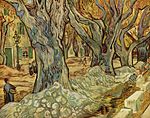Postimpressionism
Inom konsten brukar benämningen postimpressionism avse en andra generation impressionister som intresserade sig mindre för ljusets spel och mer för hur motivet mest sanningsenligt skulle överföras till dukens yta. Dessa hade tröttnat på impressionismens begränsningar och ville kunna uttrycka mer. Postimpressionism introducerades av Roger Fry i England 1910. Postimpressionisterna brukar betraktas som premodernister då de fick utomordentligt stor betydelse för fauvismen och för kubisterna Pablo Picasso och Georges Braque.
Kända konstnärer som räknas till postimpressionisterna
- Paul Cézanne (1839–1906)
- Odilon Redon (1840–1916)
- Henri Rousseau (1844–1910)
- Paul Gauguin (1848–1903)
- Vincent van Gogh (1853–1890)
- Charles Angrand (1854–1926)
- Henri-Edmond Cross (1856–1910)
- Georges Seurat (1859–1891)
- Theo van Rysselberghe (1862–1926)
- Paul Signac (1863–1935)
- Henri de Toulouse-Lautrec (1864–1901)
- Paul Sérusier (1864–1927)
- Paul Ranson (1864–1909)
- Félix Vallotton (1865–1925)
- Suzanne Valadon (1865 - 1938)
Se även
Källor
- Honour, Hugh; Fleming, John (1992). Konsten genom tiderna (3). Stockholm: Tidens förlag. sid. 615–618. ISBN 91-550-3820-4
Externa länkar
 Wikimedia Commons har media som rör Postimpressionism.
Wikimedia Commons har media som rör Postimpressionism.
| |||||||||||||
Media som används på denna webbplats
In 1889, after suffering a severe hallucinatory seizure, Van Gogh committed himself to an asylum near Saint-Rémy. While walking through the town that fall, he was impressed by the sight of men repairing a road beneath immense plane trees. Rushing to capture the yellowing leaves, he painted this composition on an unusual cloth with a pattern of small red diamonds, visible in the picture’s many unpainted areas. “In spite of the cold,” he wrote to his brother, “I have gone on working outside till now, and I think it is doing me good and the work too.” After painting this composition directly from nature, Van Gogh used it to produce a second version in the studio known as The Road Menders at Saint-Rémy. Painted on a traditional canvas covered by a ground layer, the second version is more restrained, the explosive yellows balanced by larger areas of cool color.[1]





























